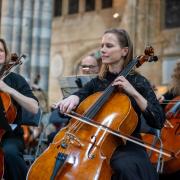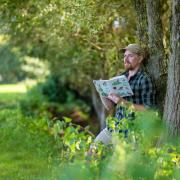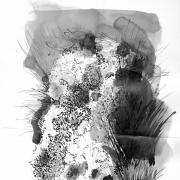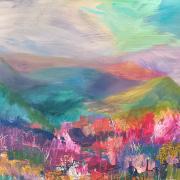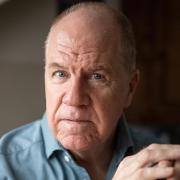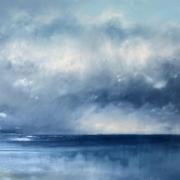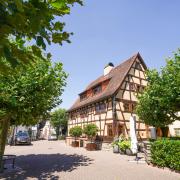CATHERINE COURTENAY talks mythic tales, trees and tango with Dartmoor’s magical artist Alan Lee

Forty five years ago, the illustrator Alan Lee moved to Chagford from Stoke Newington. He and his then wife Marja had fallen
in love with Dartmoor after visiting friends at Thornworthy for the weekend.
Alan vividly remembers his first encounter with the surrounding moorland. “There was a beautiful river that runs alongside the house and lots of woods and I was just amazed at how lush it all was, the trees and moss-covered boulders, and I thought, ‘I’ve got to spend more time here. I’ve got to live here.’ And I talked to Marja and she felt the same.” It was a transforming moment; they stayed an extra day, looked at some properties and by the end of the visit made an offer on a house which was accepted. Alan still lives in that house today. He has two studios at the back of his home. One, the older studio, is crammed with art materials, books and cases filled with artwork. The other is spacious and light-filled, with views out on to his garden.
Bits of twisted wood lie around both studios. “They are so lovely to draw,” he says.
“Forests are my great love. So many of the stories I know and love are concerned with forests.”

Alan is best known for illustrating the works of JRR Tolkien, an association which began when he was commissioned to illustrate the 1992 centenary edition of The Lord of the Rings, published 100 years after Tolkien’s birth.
He later became a conceptual designer for The Lord of the Rings films. Director Peter Jackson had seen Alan’s illustrations and persuaded him to travel to New Zealand to work on the trilogy, a task that would take six years. He later returned for another six years for the making of The Hobbit films.
It was intense. Alan was constantly drawing, guiding set builders and model makers, helping them visualise the world they were creating. There was no other source material, so from landscapes and cities, to the carving on a throne or the design
of a horse stirrup, everything needed illustrating.
And Dartmoor was never far away. “I was constantly thinking of vernacular buildings in Devon; even the gardens in Hobbiton were kind of based on the allotments here in Chagford,” he says.

The films were a huge success, with Alan winning an Oscar for his work. But his insight into their making means he’ll always view them a little differently. He reveals that, in order to make the hobbit characters look smaller, the ‘ponies’ ridden by them were actually horses wearing ‘pony suits’.
“There were times when I doubted we could pull it off, sometimes it seemed a bit shambolic, some scenes were terrible; but then through the editing process it all comes together. It’s a testament to Peter’s vision he could see through the grunge and crap and see these jewels of performance.”
Alan’s home is filled with books, paintings, sculpture and music. But it’s far better to listen to The Archers when he’s working, he says; music would be too distracting, or it might make him want to dance.
While in New Zealand he discovered the joy of Argentinian tango. “It’s not dramatic, just really nice, social dancing, not flashy, not what you see on Strictly Come Dancing.”
Alan is quiet and softly spoken. He describes himself as being “quite solitary” as a child. “Not at all sporty, a little bit of a weed, I suppose, physically.” He spent his time making castles out of cereal boxes and his playground was the greenbelt area around Uxbridge, a landscape of gravel pits, ruined pillboxes and bunkers -

and woodland.”
He was a naturally gifted
artist, attending Ealing School of Art at the age of 16. Along with the art came a love of myth and legend, particularly the Celtic and Norse myths. He loved their “magic and strangeness’, as well as the element of “horror and mortal danger”.
“It’s a kind of connection you get through time, with earlier populations,” he says. “You’re still terrified by the same things and fall in love with the same goddesses.”
“It’s because these stories have survived; they’re kind of worn into perfect shapes, like pebbles in a stream,” he says.
Is he more at home in the lands of myth and legend that inhabit his imagination?
“There are certain things about the contemporary world I find hard – some practical things like finances, tax returns – but I somehow get through it,” he says.
“With any kind of creative work you need to be able to do a lot of it in your imagination, even if you are walking around or sitting in a pub, constantly those ideas and stories circulate round and so it feels like you are in a kind of dreamy state a lot of the time.”
A familiar face around Chagford, Alan likes to have coffee or breakfast in one of the town’s cafés.
He also still walks the footpaths and surrounding moorland that so inspired him 45 years ago. “I walk for refreshment, and it energises me,” he says.
Current plans are to return to Celtic mythology with a book about British myths and legends; he may also try some creative writing, although he says: “I’m not sure of my skills in that area.”
He also wants to work with a group of locals to plant more trees around Chagford.
“I realise more and more the importance of nature, and the fragility of it,” he says.
“I have a responsibility to help people to love it as much as I do, through these stories.”




